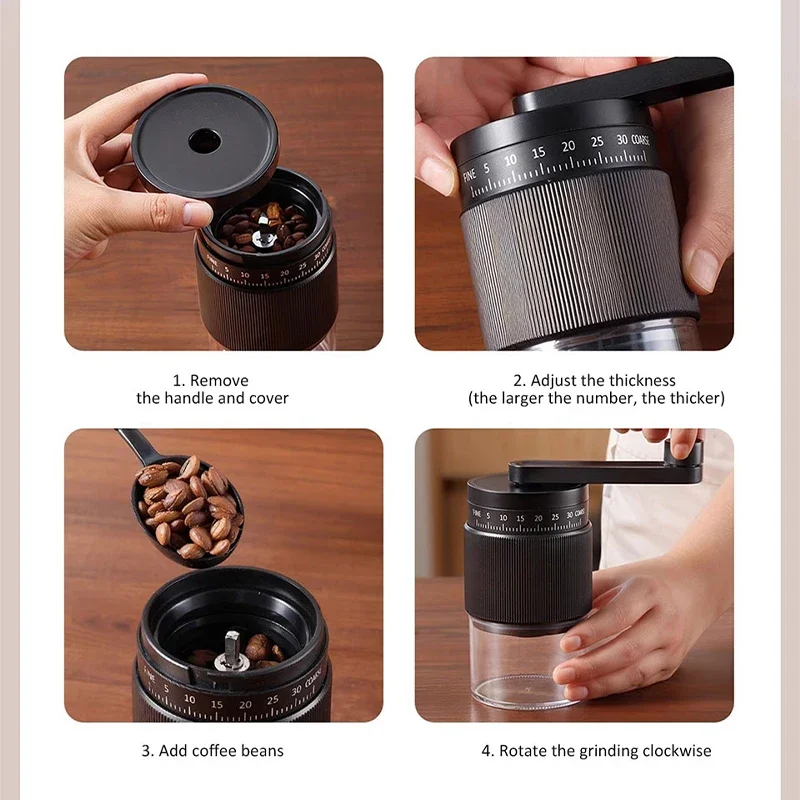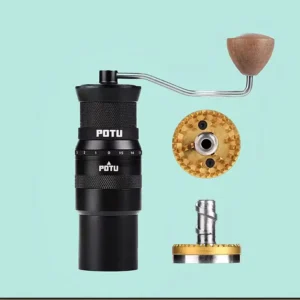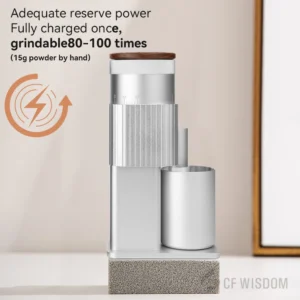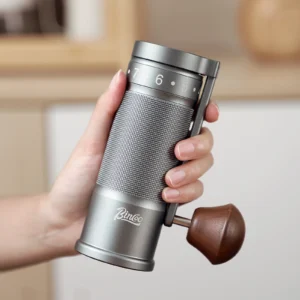Introduction: Why Ergonomics Matters for Hand Grinder Users
In the world of specialty coffee, hand crank grinders have become treasured tools for enthusiasts seeking the perfect cup. But what exactly is ergonomics when it comes to these manual coffee tools? Simply put, ergonomics refers to how well a grinder’s design works with your body—specifically your hands, wrists, and arms—during use.
The importance of ergonomic design in hand grinders goes far beyond mere comfort. A well-designed grinder can prevent pain, reduce fatigue, and help avoid long-term issues like repetitive strain injuries that can develop from regular grinding sessions. More importantly for coffee lovers, proper ergonomics directly affects how consistently you can grind your beans, ultimately impacting the quality of your brew.
With the rising popularity of manual brewing methods like pour-over, French press, and home espresso, more coffee enthusiasts are turning to hand crank coffee grinders for their precision and control. However, the repetitive motion involved—sometimes requiring 30-60 seconds of continuous rotation for just a single cup—makes ergonomic considerations essential.
Throughout this article, we’ll explore common ergonomic issues with hand grinders, identify the key design features that enhance comfort, demonstrate proper techniques, and provide guidance for selecting a grinder that matches your specific needs. Understanding the ultimate espresso grind size is important, but equally crucial is finding a comfortable way to achieve it.
Understanding Physical Impacts: Common Ergonomic Issues with Hand Crank Grinders
Manual coffee grinding, while rewarding, can take a physical toll if your grinder lacks proper ergonomic design. Understanding these physical impacts helps you recognize potential issues before they become problematic.
Common Physical Complaints
Many hand grinder users experience several types of discomfort during or after grinding:
- Hand and Wrist Pain: Often felt in the palm (particularly at the base of the thumb), finger joints, and thumb where pressure is applied
- Forearm and Shoulder Fatigue: The repetitive motion can lead to muscle fatigue that extends from the wrist up the arm to the shoulder
- Finger Discomfort: Particularly common in the fingers that grip the handle, sometimes manifesting as numbness after extended use
Specific Conditions That Can Develop
Without proper attention to ergonomics, regular manual grinding can contribute to several health conditions:
- Repetitive Strain Injuries (RSI): Damage to muscles, tendons, and nerves from repeated movements, often manifesting as pain, weakness, or numbness
- Carpal Tunnel Syndrome: Compression of the median nerve in the wrist causing pain, numbness, and tingling, often worsened by the bent wrist positions common in grinding
- Hand-Arm Vibration Syndrome: Numbness and tingling from exposure to vibration, particularly with grinders that have loose components or poorly balanced mechanisms
- General Musculoskeletal Discomfort: Overall aches in hands, arms, and shoulders that develop over time
Root Causes of Ergonomic Problems
Understanding what causes these issues helps in selecting better grinders and improving technique:
- Force Requirements: Finer grinds (like for espresso) require significantly more force than coarser grinds, putting additional strain on hands and wrists
- Awkward Hand Positions: Many grinders force users to hold their wrists at unnatural angles during operation
- Repetitive Motion: The continuous circular motion—sometimes hundreds of rotations for a batch of coffee—creates cumulative stress
- Poor Handle Design: Handles that are too short provide inadequate leverage, while those that are too thin concentrate pressure on smaller areas of the hand
- Vibration: Loose components or poorly balanced mechanisms can create vibration that transfers to your hand and arm
The challenge of adjusting grind settings for perfect espresso adds another layer of ergonomic concern, as many adjustment mechanisms require awkward finger positions or significant force to operate.
For those using manual coffee burr grinders regularly, being aware of these potential issues is the first step toward preventing them through better equipment selection and technique.
Critical Design Elements: Ergonomic Features that Make a Difference
The difference between an uncomfortable grinding experience and an enjoyable one often comes down to specific design elements that may not be immediately obvious. Understanding these features helps you recognize quality ergonomic design in hand grinders.
Handle Design – The Primary Contact Point
The handle is where your hand directly interfaces with the grinder, making its design crucial for comfort:
- Shape and Contour: Handles with slight curves that follow the natural grip of your hand reduce strain compared to perfectly straight handles
- Handle Length: Longer handles (typically 4-6 inches) provide better leverage, requiring less force for the same grinding result
- Diameter Considerations: Thicker handles distribute pressure across a larger area of your palm, while handles that are too thin create pressure points
- Material Properties: Wood handles provide natural warmth and some vibration dampening, while metal handles with silicone or rubber overlays offer secure grip even with damp hands
- Knob Design: A smooth, well-sized knob at the handle’s end prevents slipping and reduces finger strain during rotation
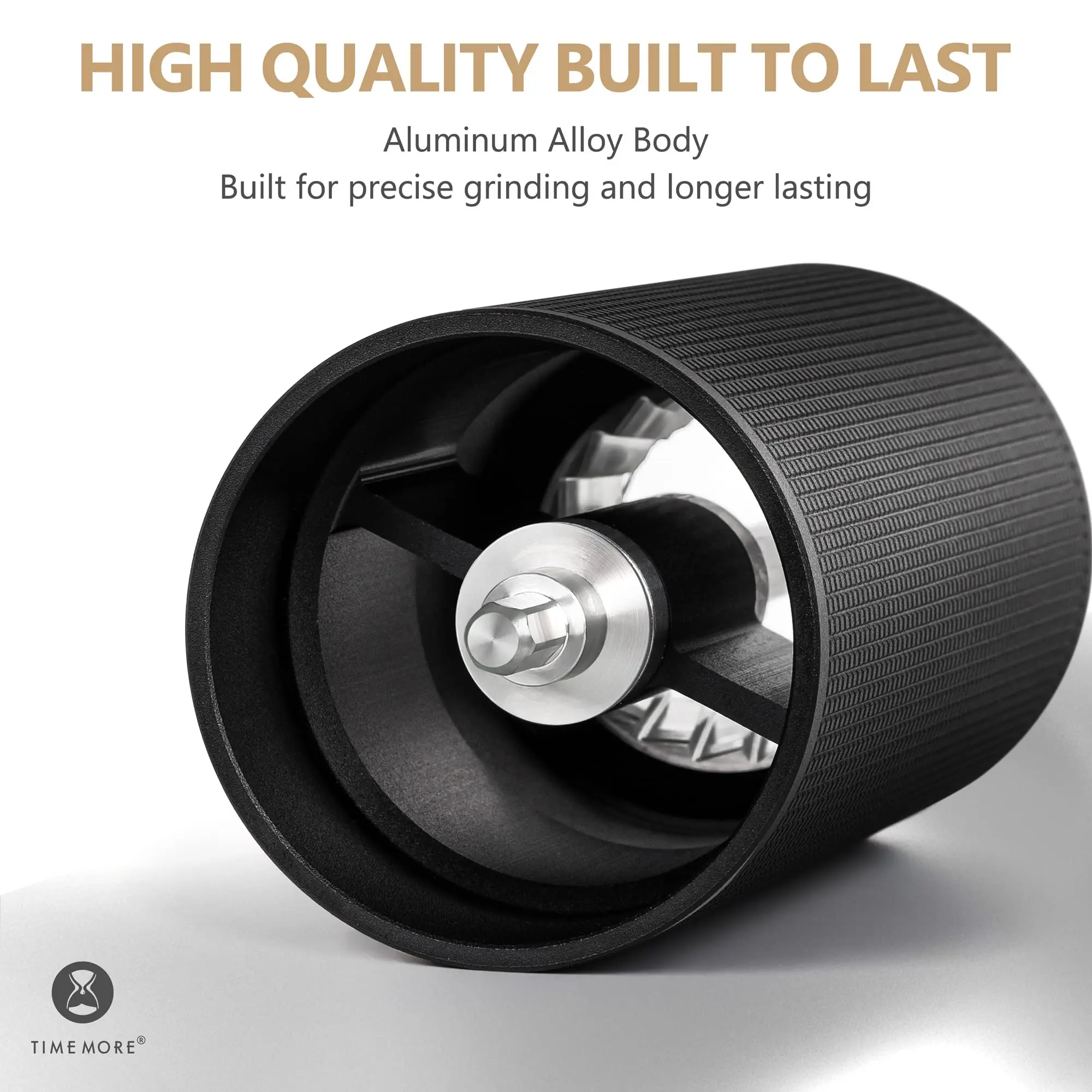
Stainless steel manual coffee grinders often feature different handle materials and designs that can significantly impact grinding comfort.
Body Design and Stability
The grinder’s body affects how securely you can hold it during operation:
- Weight Distribution: A balanced center of gravity reduces wrist strain during use
- Body Shape: Contoured bodies with textured surfaces or slight indentations provide more secure grip points
- Base Stability: Wider bases or non-slip features reduce the force needed to hold the grinder steady
- Grip Surfaces: Textured areas or silicone elements prevent slipping and reduce the grip force required
Grinding Mechanism Efficiency
The internal components directly impact how much physical effort grinding requires:
- Burr Quality: Sharp, precisely manufactured burrs cut beans more efficiently, requiring less force
- Bearing Systems: High-quality bearings create smoother rotation with less resistance
- Shaft Alignment: Proper alignment ensures even grinding with minimal binding that would otherwise increase required force
Vibration Management
Vibration during grinding can cause discomfort and fatigue:
- Material Selection: Certain materials absorb vibration better than others
- Component Fit: Tight tolerances between parts reduce rattling and vibration
- Design Elements: Features that dampen or isolate vibration from the handle reduce transmission to your hand
Adjustment and Operation
How you interact with the grinder’s controls affects overall ergonomics:
- Accessible Adjustment: Grind settings that can be changed without awkward hand positions
- Intuitive Controls: Clear, easy-to-use adjustment mechanisms that don’t require excessive force
- Bean Loading and Grounds Collection: Thoughtful design that doesn’t require uncomfortable manipulation
The connection between espresso grind settings and ergonomics is particularly important, as finer grinds require more physical effort and precise adjustment mechanisms.
For those specifically seeking a grinder for espresso, manual coffee grinders designed for espresso often include ergonomic features specifically addressing the higher force requirements of fine grinding.
Ergonomic Technique: Proper Use for Comfort and Efficiency
Even the best-designed hand grinder requires proper technique to maximize comfort and efficiency. How you position your body and hands during grinding makes a significant difference in your experience.
Proper Grinding Posture and Technique
Starting with the correct approach prevents unnecessary strain:
- Body Position: Stand with feet shoulder-width apart or sit with back straight. The grinder should be at a comfortable height—approximately elbow level—whether you’re using a countertop or holding it
- Wrist Alignment: Maintain your wrist in a neutral position (aligned with your forearm) as much as possible rather than bent at extreme angles
- Hand Placement: Place your dominant hand on the handle and use your other hand to stabilize the grinder body
- Motion Technique: Use your shoulder and upper arm muscles rather than just your wrist to power the grinding motion—these larger muscle groups fatigue less quickly
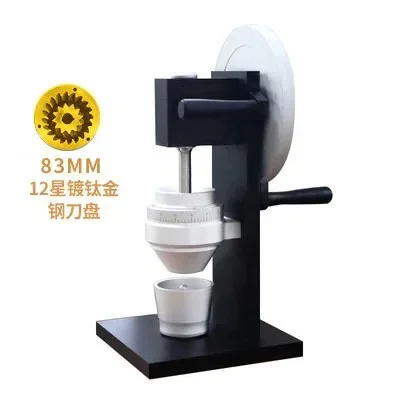
Understanding the correct grind setting for espresso is important, but equally crucial is developing a technique that allows you to maintain that consistency without strain.
Managing Grinding Sessions
For larger batches or finer grinds that require more time:
- Pacing Strategy: Maintain a steady, moderate pace rather than fast grinding that quickly leads to fatigue
- Rest Intervals: For larger batches, take brief 15-30 second breaks every minute of continuous grinding
- Hand Alternation: Switch your grinding hand periodically if possible, though this requires practice to maintain consistency
- Warning Signs: If you feel sharp pain (rather than normal muscle fatigue), stop immediately and rest
Surface and Environmental Considerations
Your workspace setup affects grinding comfort:
- Work Surface Height: The ideal countertop height places the grinder so your elbow bends at approximately 90 degrees
- Stability Enhancement: Place a non-slip mat under the grinder if not holding it
- Body Position: Stand directly in front of the grinder rather than reaching across or grinding at an angle
Adaptation Strategies
Modifying your approach for special circumstances:
- Smaller Hands: Focus on grip position higher on the handle for better leverage
- Limited Strength: Use both hands on the handle when possible, or secure the grinder between your knees when seated
- Alternative Gripping: Experiment with different hand positions to find what works best for your specific grinder design
Precision manual grinders often require less force overall, making them suitable choices for those concerned about comfort during extended use.
The 30-second espresso rule relates not just to brewing but can be applied to pacing your grinding sessions with appropriate breaks to prevent fatigue.
Maintenance for Better Ergonomics: Keeping Your Grinder in Peak Condition
A well-maintained hand grinder requires significantly less physical effort to operate. Regular maintenance not only extends the life of your grinder but directly improves the ergonomic experience by reducing the force needed for grinding.
Key Maintenance Areas Affecting Ergonomics
- Burr Cleaning: Coffee oils and fine particles build up between burr teeth, increasing resistance. Regular cleaning keeps burrs cutting efficiently with less required force
- Bearing Lubrication: The central shaft and bearings need occasional lubrication with food-safe grease to maintain smooth rotation
- Handle Mechanism: Checking and tightening the handle connection prevents wobbling that causes ergonomic strain
- Alignment Checks: Ensuring burrs remain properly aligned prevents binding that increases required force
Maintenance Schedule Recommendations
- After Each Use: Brush loose grounds from visible burr surfaces
- Weekly (for daily users): Remove grounds from burr teeth using a small brush
- Monthly: Thorough cleaning of all grinding components
- Every 3-6 Months: Check and apply food-safe lubricant to bearings if needed
Tools and Supplies Needed
- Soft brushes (toothbrushes work well)
- Food-safe grease for bearings
- Compressed air (optional for deep cleaning)
- Screwdriver set for disassembly
Warning Signs of Maintenance-Related Ergonomic Issues
- Increased resistance during grinding
- New vibrations or wobbling of the handle
- Inconsistent grind results requiring more adjustment manipulation
- Unusual sounds during operation
Maintaining manual coffee grinders properly is essential for both grind quality and comfortable operation. A well-maintained grinder might require only half the force of a neglected one for the same grind.
For those interested in long-term use, mechanical coffee grinders with serviceable components allow for regular maintenance that preserves ergonomic performance over time.
Selecting Your Perfect Match: Choosing an Ergonomic Hand Grinder
Finding a hand grinder that matches your specific needs requires considering both your physical characteristics and intended use patterns. This section helps you identify which features matter most for your situation.
Understanding Your Personal Needs
Start your selection process by assessing these factors:
- Hand Size and Strength: Larger hands generally benefit from thicker handles and larger grinders, while smaller hands might prefer compact designs with appropriate grip sizes
- Existing Conditions: If you have arthritis, carpal tunnel, or previous hand injuries, prioritize grinders with smooth operation and minimal required force
- Grinding Volume: Daily grinding for multiple cups requires more ergonomic considerations than occasional use
- Brewing Methods: Different methods require different grind sizes and volumes, affecting your ergonomic needs
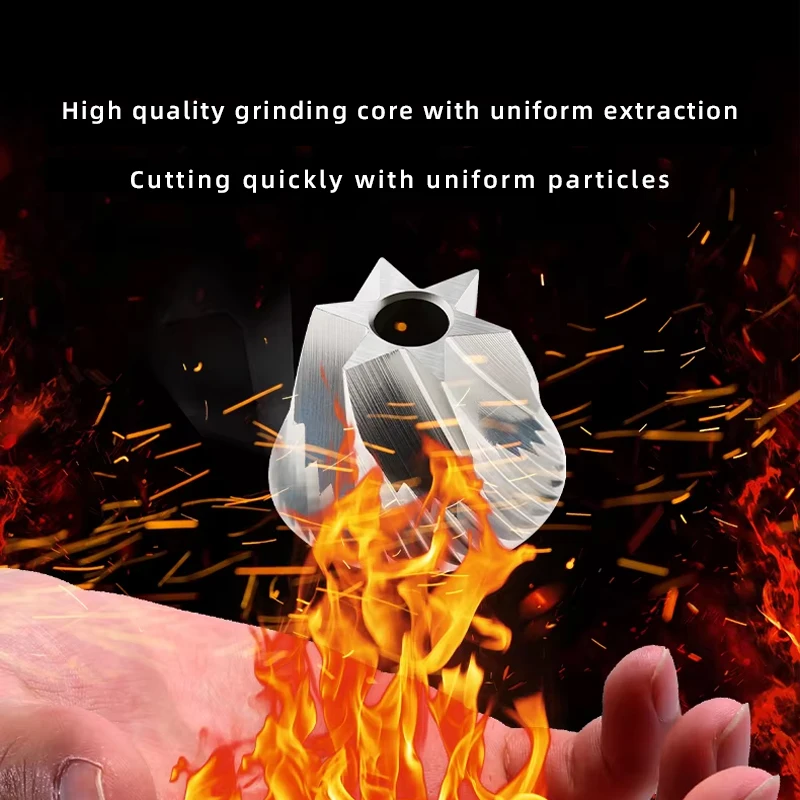
Understanding the perfect espresso grind requirements helps you select a grinder that can achieve fine grinds without excessive strain.
Priority Ergonomic Features Based on Usage
Different usage patterns require prioritizing different features:
- High-Volume Users (grinding daily for multiple people):
- Premium bearing systems for smooth operation
- Larger capacity to reduce refill frequency
Maximum handle length for leverage
Travel Users:
- Lighter weight and compact design
- Foldable handles that maintain proper length when deployed
Stable base for use on uneven surfaces
Multi-Method Brewers:
- Easily adjustable grind settings that don’t require force
- Clear adjustment markers to reduce manipulation time
- Consistent performance across grind size ranges
Evaluating Key Ergonomic Elements
When handling potential grinders, assess these specific aspects:
- Handle Assessment: Test the handle rotation for at least 30 seconds—does it remain comfortable? Can you maintain a neutral wrist position?
- Body Evaluation: Hold the grinder body—does it fit securely in your hand without slipping? Is the weight distributed evenly?
- Mechanism Smoothness: Does the handle turn with consistent resistance or does it bind at certain points?
- Adjustment Testing: Can you change settings easily without awkward finger positions or excessive force?
Understanding Trade-offs
Most grinder selections involve balancing competing factors:
- Size vs. Portability: Larger grinders often offer better ergonomics but are less portable
- Weight vs. Stability: Heavier grinders stay put during grinding but may cause fatigue when held
- Features vs. Budget: Premium ergonomic features often come with higher price tags
Portable coffee grinders offer convenience but sometimes require ergonomic compromises compared to their larger counterparts.
Fine Adjustment Hand Grinder, Precision Manual Grinder, Travel Coffee Grinder
Price range: $185.11 through $494.63 Select options This product has multiple variants. The options may be chosen on the product pageHand Burr Grinder, Hand Crank Coffee Grinder, Manual Espresso Grinder, Portable Coffee Grinder
Price range: $262.72 through $300.22 Select options This product has multiple variants. The options may be chosen on the product pageManual Burr Mill, Manual Coffee Grinder Stainless Steel, Manual Coffee Mill Grinder, Mechanical Coffee Grinder
Price range: $127.26 through $130.32 Select options This product has multiple variants. The options may be chosen on the product pageHand Burr Grinder, Manual Coffee Grinder Stainless Steel, Precision Manual Grinder
Price range: $183.64 through $187.52 Select options This product has multiple variants. The options may be chosen on the product page
The ergonomic differences between manual and automatic espresso grinders are significant and worth considering if you primarily prepare espresso.
Alternative Solutions: When Hand Grinding Becomes Challenging
Sometimes, despite the best equipment and technique, hand grinding may become physically difficult or uncomfortable. Recognizing when to consider alternatives is important for your long-term enjoyment of quality coffee.
Recognizing When to Consider Alternatives
Signs that manual grinding may be causing problems include:
* Persistent pain that continues after grinding sessions
* Increasing fatigue with even short grinding sessions
* Numbness or tingling in fingers that doesn’t quickly subside
* Decreased grip strength noticed in other activities
Temporary Alternatives During Recovery
If you’re experiencing strain but want to continue enjoying freshly ground coffee:
* Ask a household member to handle grinding temporarily
* Pre-grind larger batches (recognizing some flavor loss) to reduce frequency
* Use a coffee shop grinding service for a short period
Semi-Manual Options That Reduce Physical Effort
Several intermediate solutions maintain quality while reducing physical strain:
- Tabletop Hand Grinders: Models that clamp to countertops eliminate the need to hold the grinder body, allowing you to focus effort on turning the handle
- Grinders with Mechanical Advantage: Some designs incorporate gearing systems that multiply force, making grinding easier but slightly slower
- Power Attachments: Some manual grinders can accept drill attachments for occasional power assistance
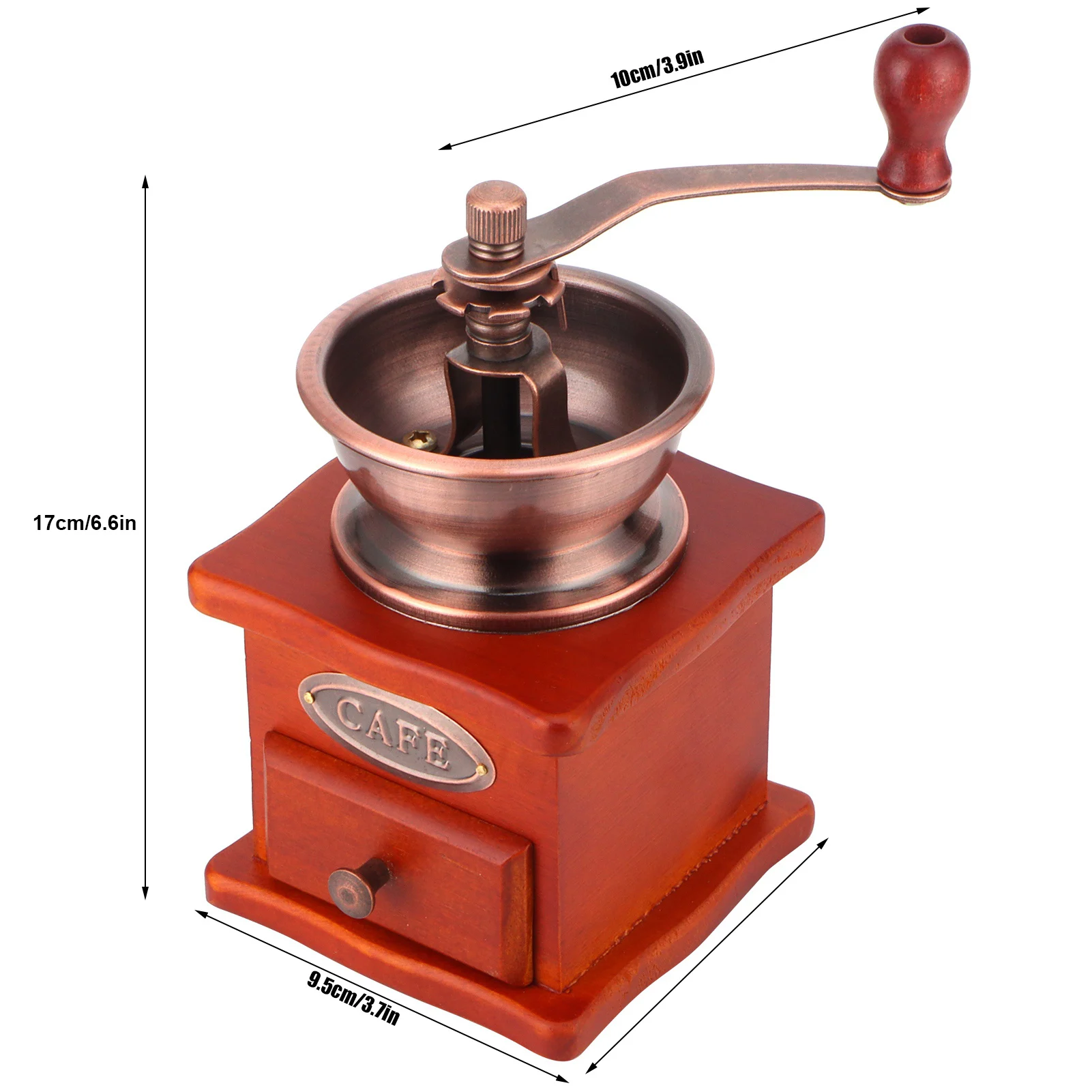
Understanding espresso grind size requirements helps you select appropriate alternatives that can still achieve the consistency needed.
Full Alternatives That Maintain Quality
If hand grinding becomes impractical:
* Low-speed electric burr grinders provide similar grind quality with minimal heat generation
* Look for electric models with the same burr types as quality manual grinders
* Consider noise levels and counter space requirements when transitioning
Modification Possibilities for Existing Grinders
Before replacing your grinder, consider these modifications:
* Handle extensions can improve leverage (though be cautious about putting too much stress on the shaft)
* Grip enhancements such as silicone sleeves or tennis racket grip tape can improve comfort
* Mounting brackets can be purchased or fabricated to secure your grinder to a counter
Manual burr mills often accept modifications more easily than highly specialized grinders, making them adaptable to changing needs.
Advanced Considerations: Ergonomics for Different Brewing Methods
Each coffee brewing method requires specific grind sizes and volumes, creating unique ergonomic challenges. Understanding these differences helps you optimize both your grinder selection and technique.
Espresso Grinding Ergonomics
Espresso presents the greatest ergonomic challenge due to:
* Ultra-fine grind requiring maximum force
* High precision demands for consistent extraction
* Frequent adjustment needs for dialing in shots
Ergonomic solutions for espresso grinding:
* Select grinders with exceptional bearing quality specifically designed for fine grinding
* Consider tabletop models that can be secured during the high-force grinding
* Use proper technique with larger muscle groups and take frequent breaks
* Look for precision adjustment mechanisms that don’t require excessive force
French Press Grinding Ergonomics
French press brewing offers ergonomic advantages:
* Coarser grind requires significantly less force
* Lower precision tolerance reduces adjustment frequency
* Often requires larger volume, increasing session duration
Ergonomic approaches for French press:
* Focus on grinders with larger bean capacities to reduce refill frequency
* Consider handle comfort for longer grinding sessions rather than maximum leverage
* Use a more relaxed grip since less force is required
Pour-Over Grinding Ergonomics
Pour-over brewing presents moderate challenges:
* Medium grind size with moderate force requirements
* High consistency demands for even extraction
* Often prepared as single cups, requiring precise small-batch grinding
Pour-over ergonomic considerations:
* Prioritize grinders with excellent stability at medium settings
* Focus on consistent speed technique to maintain grind uniformity
* Consider grinders with easy fine-tuning mechanisms for dialing in perfect flow rate
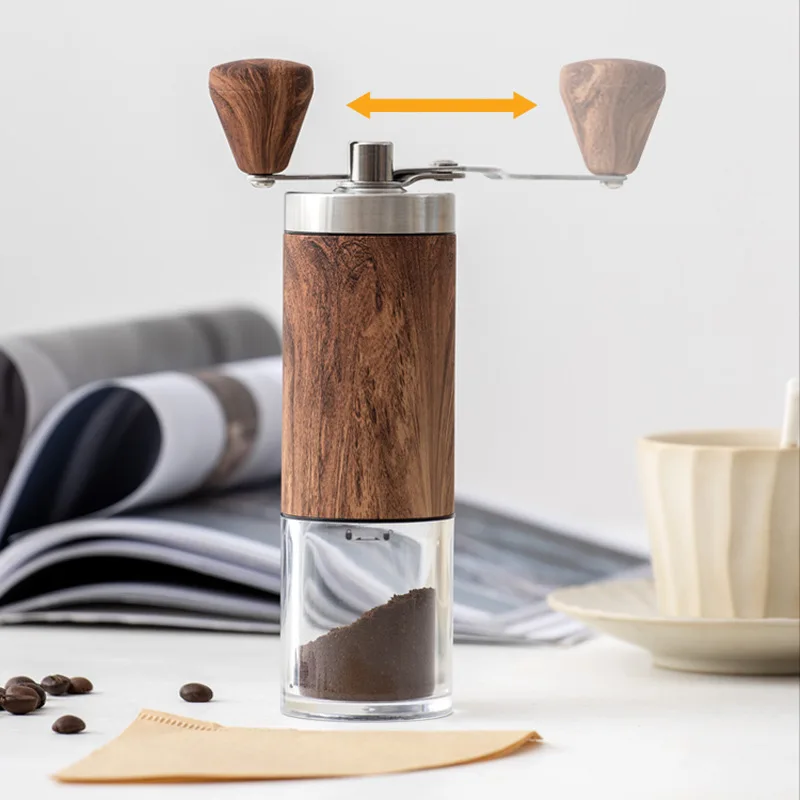
Finding the perfect grind setting for espresso requires different ergonomic considerations than grinding for other methods.
Turkish Coffee Grinding Ergonomics
Turkish coffee presents unique challenges:
* Extremely fine grind approaching powder consistency
* Maximum force requirements throughout grinding session
* Small volume but extended grinding time
Turkish coffee ergonomic approaches:
* Specialized grinders with optimized burrs for powdery grinds
* Maximum leverage handle designs
* Strict attention to proper posture and technique
* More frequent breaks during grinding sessions
The differences between burr and blade grinders extend to ergonomics as well, with burr grinders typically offering better ergonomic experiences despite requiring more force.
For those who frequently prepare espresso, manual espresso grinders with specific design features can significantly improve the ergonomic experience despite the high force requirements.
Listening to Your Body: Preventing and Addressing Discomfort
The enjoyment of hand-ground coffee shouldn’t come with physical discomfort. Learning to recognize warning signs and address them early prevents minor discomfort from developing into significant problems.
Importance of Early Intervention
Small adjustments made at the first sign of discomfort can prevent larger issues from developing. The cumulative nature of repetitive strain means that continuing through pain often leads to longer recovery periods later.
Warning Signs That Indicate Developing Problems
Be alert for these indicators that your grinding routine may be causing issues:
- Pain that persists after grinding: Normal muscle fatigue should resolve within minutes of completing your grinding session
- Tingling or numbness: Particularly in fingers or palm, indicating potential nerve compression
- Decreased grip strength: Difficulty holding other objects or performing regular tasks
- Waking up with stiff or sore hands: Indicating inflammation from previous day’s activities
Short-Term Remediation Strategies
If you notice early signs of discomfort:
- Rest: Take a complete break from grinding for 1-2 days
- Ice: For acute discomfort, apply ice for 15-20 minutes to reduce inflammation
- Gentle stretches: Extend fingers wide, then make a fist; repeat 5-10 times
- Wrist rotations: Move wrists in gentle circles in both directions
- Consider temporary alternatives: Use pre-ground coffee or alternative grinding methods temporarily
Long-Term Prevention Approaches
Proactive measures to maintain hand and wrist health:
- Hand strengthening: Squeeze a soft stress ball or therapy putty regularly
- Grip variation: Practice using different grip styles when possible
- Warm-up routine: Before grinding, gently stretch and warm hands under warm water
- Equipment evaluation: Regularly reassess if your grinder still meets your ergonomic needs
- Technique refinement: Periodically check your grinding posture and technique
Handheld coffee grinders with different grip profiles may work better for different users, so being willing to change equipment if persistent issues occur is important.
If discomfort persists despite rest and technique adjustments, consult a healthcare professional rather than risking long-term injury. Many repetitive strain issues respond well to early intervention but can become chronic if ignored.
Regular cleaning of manual burr grinders not only maintains performance but reduces the force required for grinding, helping prevent strain and discomfort.
Conclusion: Balancing Craft, Comfort, and Quality in Hand Grinding
The pursuit of the perfect cup through manual grinding represents a beautiful balance between craftsmanship and sensory enjoyment. The ergonomic aspects of this process aren’t merely about avoiding discomfort—they’re about enhancing the entire coffee experience through tools that work in harmony with your body.
Throughout this guide, we’ve explored how the design of a grinder impacts your physical comfort, how proper technique can prevent strain, and how maintenance keeps your grinding experience smooth and enjoyable. We’ve seen that different brewing methods create unique ergonomic challenges and that listening to your body provides valuable feedback about your equipment and technique.
The ideal hand grinding experience comes from finding personal balance—a grinder that fits your hands, a technique that works with your body, and a maintenance routine that keeps everything working smoothly. Remember that the perfect grind should bring joy to the process, not physical discomfort.
By applying these ergonomic principles to your coffee routine, you’ll not only protect your long-term hand and wrist health but also enjoy more consistent grinding results—ultimately leading to better coffee in your cup, day after day.
Fine adjustment hand grinders with excellent ergonomics allow you to focus on the sensory experience of coffee preparation rather than physical discomfort.
BONUS: Ergonomic Accessories for Enhanced Hand Grinding Experience
Beyond the grinder itself, several accessories can significantly improve your grinding ergonomics:
- Grinder Mounts and Stabilizers:
- Suction-base holders that secure your grinder to the countertop
- Table-edge clamps that hold the grinder firmly while you turn the handle
Custom wooden bases that add stability and raise height for better positioning
Non-Slip Mats and Bases:
- Silicone pads that prevent grinder movement during operation
- Weighted bases that add stability without requiring you to hold the grinder body
Textured counter mats that improve grip while protecting surfaces
Handle Extensions and Grips:
- Silicone handle covers that improve comfort and reduce slippage
- Custom handle extensions that increase leverage for difficult grinding
Ergonomic knob replacements that better fit hand contours
DIY Solutions:
- Tennis racket grip tape wrapped around handles
- Custom wooden handle replacements
- Silicone putty molded to create personalized grip shapes
These accessories can address specific ergonomic challenges without requiring replacement of an otherwise excellent grinder, allowing you to customize your grinding experience to your personal comfort needs.

